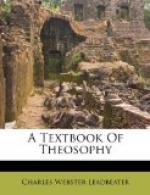This ego is the man during the human stage of evolution; he is the nearest correspondence, in fact, to the ordinary unscientific conception of the soul. He lives unchanged (except for his growth) from the moment of individualization until humanity is transcended and merged into divinity. He is in no way affected by what we call birth and death; what we commonly consider as his life is only a day in his life. The body which we can see, the body which is born and dies, is a garment which he puts on for the purposes of a certain part of his evolution.
Nor is it the only body which he assumes. Before he, the ego in the higher mental world, can take a vehicle belonging to the physical world, he must make a connection with it through the lower mental and astral worlds. When he wishes to descend he draws around himself a veil of the matter of the lower mental world, which we call his mental body. This is the instrument by means of which he thinks all his concrete thoughts—abstract thought being a power of the ego himself in the higher mental world.
Next he draws round himself a veil of astral matter, which we call his astral body; and that is the instrument of his passions and emotions, and also (in conjunction with the lower part of his mental body) the instrument of all such thought as is tinged by selfishness and personal feeling. Only after having assumed these intermediate vehicles can he come into touch with a baby physical body, and be born into the world which we know. He lives through what we call his life, gaining certain qualities as the result of its experiences; and at its end, when the physical body is worn out, he reverses the process of descent and lays aside one by one the temporary vehicles which he has assumed. The first to go is the physical body, and when that is dropped, his life is centred in the astral world and he lives in his astral body.
The length of his stay in that world depends upon the amount of passion and emotion which he has developed within himself in his physical life. If there is much of these, the astral body is strongly vitalized, and will persist for a long time; if there is but little, the astral body has less vitality, and he will soon be able to cast that vehicle aside in turn. When that is done he finds himself living in his mental body. The strength of that depends upon the nature of the thoughts to which he has habituated himself, and usually his stay at this level is a long one. At last it comes to an end, and he casts aside the mental body in turn, and is once more the ego in his own world.
Owing to lack of development, he is as yet but partially conscious in that world; the vibrations of its matter are too rapid to make any impression upon him, just as the ultra-violet rays are too rapid to make any impression upon our eyes. After a rest there, he feels the desire to descend to a level where the undulations are perceptible to him, in order that he may feel himself to be fully alive; so he repeats the process of descent into denser matter, and assumes once more a mental, an astral and a physical body. As his previous bodies have all disintegrated, each in its tarn, these new vehicles are entirely distinct from them, and thus it happens that in his physical life he has no recollection whatever of other similar lives which have preceded it.




